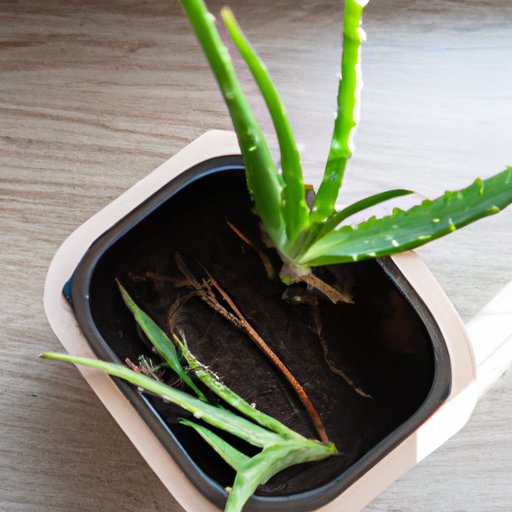
I. Introduction
An aloe plant is a hardy and low-maintenance succulent that is easy to care for, making it an ideal houseplant for beginners or anyone looking to add some greenery to their homes. Aloe plants are not only beautiful but also known for their medicinal properties that can be used in skincare and natural remedies. This article will provide an in-depth guide on how to care for an aloe plant, from watering and light requirements to propagation techniques and common issues that may arise.
II. Start with the Basics
Aloe plants are accustomed to dry, arid conditions, and require plenty of sunlight, proper soil and drainage, and the right temperature to grow and thrive. They prefer to be slightly neglected and can be forgiving if neglected for a while.
III. Discuss Watering
Aloe plants only need to be watered every two weeks, depending on the climate and indoor humidity levels. It’s best to water only when the soil is completely dry to touch, and to drain any water that has accumulated in the tray below the pot. Overwatering can cause the aloe plant to rot from the roots, so make sure to monitor the soil’s moisture level.
IV. Discuss Sunlight
Aloe plants love exposure to sunlight and require at least six hours of indirect sunlight per day. However, they can also be placed in a shaded area or under a grow light if you live in an area that has low natural light levels. For indoor plants, ensure that they are placed in a sunny window, and move them occasionally to avoid the plant reaching towards the light from only one side.
V. Identify Feeding Requirements
Aloe plants do not require much feeding since they are low maintenance. However, they need to be fed once or twice per year with a balanced, slow-release fertilizer that contains nitrogen, phosphorus, and potassium. Apply the fertilizer during the growing season, which is usually spring to early summer.
VI. Diagnose Common Issues
Aloe plants are prone to pests and diseases such as spider mites, scale insects, and root rot. To prevent a pest infestation, always inspect the plant before bringing it indoors and keep it away from other infected plants. In case of any infestation, isolate the aloe plant and use natural remedies such as neem oil or insecticidal soap.
VII. Propagation Techniques
Propagation is the process of growing new aloe plants from mature ones. Aloe plants are propagated using offsets, which are small offsets produced by the mother plant. They sprout from the base of the plant, and with time, they can be separated from the mother plant and propagated to produce new ones. Additionally, aloe plants can also be propagated through division, which separates the mature plant’s offshoots with roots. Keep the planted offsets moist and watered until they are established.
VIII. Provide Helpful Tips
It’s important to repot your aloe plant every two to three years to ensure that roots have enough space to grow. To add to this, the best pot for aloe is one that has adequate drainage holes, ensuring that the soil doesn’t retain water. Also, it’s best to grow in sandy, well-drained soil that ensures the roots aren’t waterlogged.
If you’re looking for home remedies using your aloe plant, know that the gel of the plant has anti-inflammatory, moisturizing properties that make for a great natural skincare product. It can also be added to smoothies, juices, and other beverages for an extra boost of nutrients.
IX. Conclusion
It’s important to give your aloe plant the proper care to ensure optimal growth and health. By following the above tips, you can avoid common mistakes such as overwatering, neglecting light exposure, and poor soil drainage, among others. Remember to keep an eye out for common issues such as pests and diseases, and propagate your plant for added greenery in your home.





